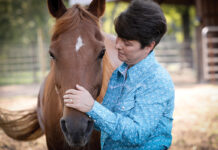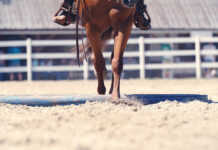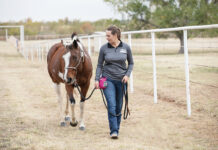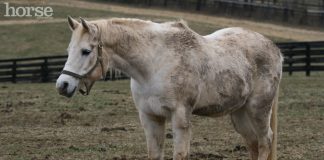Each season brings its own set of challenges for horse owners. Plan ahead to keep your horse happy and healthy all year long.
 Winter
Winter- Increase your horse’s hay. Horses keep warm through the process of digesting fiber. Most healthy horses will be able to stay comfortable outdoors in most weather conditions if they have free access to hay and shelter, even if they are unblanketed. You can keep round bales in your pasture or feed a few flakes of hay for each horse several times each day. Throw your horse an extra couple of flakes on very cold nights. Read more on winter feeding.
- Horses that have access to plenty of grass during the warmer months may need supplemental calories in the winter. Conversely, a horse whose work is scaled back in the winter may need fewer calories. Adjust your horse’s grain accordingly, but remember that forage (hay or pasture) is the foundation of your horse’s diet and should be his primary food source. Consult your veterinarian before making any major changes to your horse’s diet.
- If you live in an area with lots of ice and snow, you may need to change your horse’s shoeing. Many horses do just fine going barefoot in the winter, but if you need to keep your horse shod, ask your farrier about special shoes for winter. Borium or studs can increase traction, while special pads are available to keep snow from building up in the foot. Even if you leave your horse barefoot, continue to have your farrier trim his hooves every six to eight weeks.
- Horses must always have clean water available for drinking. Checking your horse’s water supply regularly for ice is imperative in the winter. You may need to break and remove ice several times each day. If your horse has an aversion to drinking very cold water, another option is to invest in heated buckets for your stalls, or water heaters for your outdoor troughs. Just make sure the cords are out of your horse’s reach.
- Horses are much less sensitive to cold than humans are. It might make you feel better to know that your horse is tucked away in his stall in a closed-up barn, but this can cause respiratory ailments as a result of poor ventilation. He’ll be healthier if he’s turned out with access to shelter or kept in a well-ventilated barn, even when it’s very cold.
- If you decide to blanket your horse during cold weather, remove his blanket daily to check for rubs or sores, and to check his body condition to make sure he isn’t dropping weight. If the temperature rises during the day, feel under your horse’s blanket to make sure he isn’t sweating.
- You may have to scale back your horse’s work schedule during the colder months, but try to get him out for some light work a few times a week so he won’t lose his fitness base by springtime.
 Spring
Spring
- Schedule your annual vet appointment. Get your horse’s vaccinations done to keep him healthy as warm weather arrives. If you plan to travel to shows or trail rides during the summer, you may need to have a negative Coggins test and a health certificate. Your spring vet visit is also a great opportunity to discuss any concerns you might have with your veterinarian and get the latest information on local equine health issues.
- Design your deworming schedule. Rather than going with a cookie-cutter deworming plan, ask your vet about doing a fecal egg count (FEC) test. This will determine what type of parasite load your horse is carrying.
- Limit your horse’s grass intake. If you’re lucky enough to have your horse on a farm with nice, green pastures, use caution in the spring. Lush, young grass can lead to serious health problems in horses, especially laminitis. Keep your horse stabled or on a dry lot for part of the day and gradually increase his time on grass. If you don’t have that option, purchase a grazing muzzle to restrict his intake.
- Check your fences. Winter weather can do a number on your fences. Take a walk or ride around the perimeter and look for broken boards, loose posts, protruding nails and drooping tape or wire. Make any repairs right away.
- Give your barn a clean sweep. Schedule a day—or even a full weekend—to thoroughly spring clean your barn. Sweep out the grain room, clean up the hay storage area, take down cobwebs, get rid of clutter and clean and store your winter blankets.
- Plan your conditioning program and stick to it. Proceed with caution as the weather improves. The less work your horse has had during the winter, the longer it will take to safely bring him back into shape. Older horses will take longer than younger horses to return to fitness. Start out slowly with lots of walking and minimal trotting and cantering. Your horse may be feeling good, but don’t let him do too much too soon. You don’t want to start the spring sidelined with an injured equine.
 Summer
Summer
- Be sure your horse has adequate shade. This can be from trees or a structural shelter, but make sure there is sufficient shade throughout the day for every horse in your pasture. Alternatively, you can bring your horse indoors during the hottest part of the day.
- Eliminate standing water and remove manure in paddocks to get rid of fly and mosquito breeding grounds. When the weather is hot and dry, you can drag your paddocks to spread manure piles so the parasite eggs and larvae will dry in the sun. Only do this if you are able to keep horses out of the paddock for the next two weeks to avoid the risk of parasite infection. You can also protect your horse from insects by using fly spray, fly masks and fly sheets.
- Horses with white markings on their noses are at risk of getting painful sunburns. Apply sunscreen or invest in a fly mask with an extension that covers the nose. You may also choose to keep your horse indoors during the hottest, sunniest afternoon hours and turn him out overnight.
- Grain, especially sweet feed, can spoil faster in heat and humidity. Keep your feed stored out of sunlight and buy only what you need instead of storing large quantities in your feed room where it can get moldy.
- Check pasture water regularly. Even if it looks clean, feel the temperature to make sure the sun hasn’t it heated up to the point where it is too warm for your horse to drink.
- Purchase your winter hay. Summer is the time to find a source for hay and store your first load. Even if you don’t feed much hay until winter, procure it now so you’re not scrambling to find a good source when fall rolls around.
 Autumn
Autumn
- Clean up the tack room. Thoroughly clean your horse’s fly masks and sheets, store fly sprays and other liquids, and any show tack or other equipment that you won’t be using once cold weather sets in. Store your summer wares in a place where they won’t freeze or become moldy while they’re out of use.
- Call the dentist. Have your vet or an equine dental technician out to check your horse’s teeth. Most adult horses are fine with one annual check-up, but young and senior horses need their teeth checked every six months. For senior horses especially, it’s important to make sure they are able to properly chew their hay to avoid excessive winter weight loss.
- Prepare your horse’s cold-weather wardrobe. In addition to blankets, if you choose to use them, consider investing in a cooler. As the temperature begins to drop and your horse’s winter coat grows in, it’s important to cool him out properly if he works up a sweat during a ride. Using a cooler, usually made of wool or fleece, will keep him from becoming chilled.
This article originally appeared in the 2012 issue of Horses USA. Click here to purchase the most recent issue.





